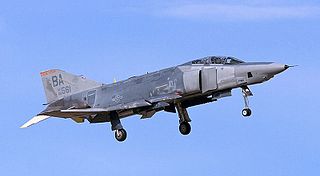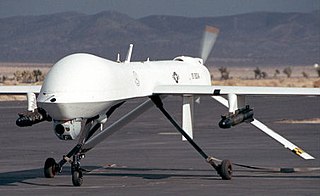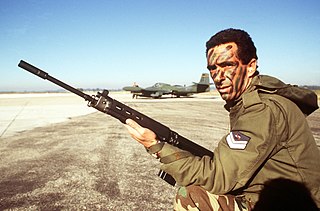
The 363rd Intelligence, Surveillance, and Reconnaissance Group is a United States Air Force unit stationed at Joint Base Langley-Eustis. It is assigned to the 363rd Intelligence, Surveillance and Reconnaissance Wing. It was activated in February 2015, after having been returned to regular service after operating as a provisional unit. The group has its origins in the 363rd Fighter Group, activated on 1 August 1943 at Hamilton Field, California. The unit was credited with 41 victories but lost 43 of its own aircraft during World War II.

The 67th Cyberspace Operations Group is a unit of the 67th Cyberspace Wing. Headquartered on Kelly Field Annex's Security Hill, the group is an Air Force information operations unit.

The 17th Attack Squadron is a squadron of the United States Air Force. It is assigned to the 432d Wing, and stationed at Creech Air Force Base in Indian Springs, Nevada. The 17th is equipped with the MQ-9 Reaper.

The 30th Reconnaissance Squadron is a reconnaissance test squadron assigned to the 432nd Operations Group, 432nd Wing at Creech Air Force Base, Nevada. The 30 RS flies the RQ-170 Sentinel UAV out of the Tonopah Test Range Airport in Tonopah.

The 26th Information Operations Wing is an inactive United States Air Force unit. Its last assignment was with United States Air Forces in Europe at Ramstein Air Base, Germany, where it was inactivated on 5 July 2006.

The 20th Intelligence Squadron is a United States Air Force unit, assigned to the 363d Intelligence, Surveillance, and Reconnaissance Group at Offutt Air Force Base, Nebraska. It has served at Offutt since June 1992, when it was activated as the 20th Air Intelligence Squadron.

The 91st Cyberspace Operations Squadron is an active United States Air Force unit, currently assigned to the 67th Cyberspace Wing at Kelly Annex, part of Lackland Air Force Base, Texas.

The United States Air Force's 9th Combat Operations Squadron is an Air Force Reserve Command space operations unit located at Vandenberg Space Force Base, California. The 9th augments the 614th Air and Space Operations Center in operating the Joint Space Operations Center, performing combat operations, plans, strategy and intelligence assessments that enable the Commander, Joint Functional Component Command for Space to command and control space forces by providing worldwide space effects and theater support to combatant commanders.

The 16th Airborne Command and Control Squadron was a United States Air Force squadron assigned to Air Combat Command's 461st Air Control Wing, 461st Operations Group, stationed at Robins Air Force Base, Georgia. The squadron previously flew the Northrop Grumman E-8C JSTARS, providing airborne battle management, command and control, surveillance, and target acquisition with the last E-8C flight on September 8, 2022.

The 363d Intelligence, Surveillance and Reconnaissance Wing is a United States Air Force unit. The wing is assigned to the United States Air Force Sixteenth Air Force, stationed at Joint Base Langley-Eustis, Virginia.

The 18th Attack Squadron is a squadron of the United States Air Force. It is assigned to the 432d Operations Group, and has been stationed at Creech Air Force Base, Nevada since 2009. The squadron conducts strike, intelligence, surveillance and reconnaissance missions, operating the General Atomics MQ-1 Predator unmanned aerial vehicle.

The 25th Attack Group is an active United States Air Force unit, stationed at Shaw Air Force Base, South Carolina. It was activated in February 2018 as a geographically separate unit to operate unmanned aerial vehicles and is assigned to the 432d Wing, which is located at Creech Air Force Base, Nevada. As of 2020, the group manages five General Atomics MQ-9 Reaper attack squadrons, as well as the 25th Operations Support Squadron, which provides intelligence, weather, and administrative support.

The 42d Electronic Combat Squadron is a United States Air Force unit. Its current assignment is with the 55th Electronic Combat Group at Davis–Monthan Air Force Base, Arizona as a geographically separated unit from its parent wing, the 55th Wing at Offutt Air Force Base, Nebraska. The squadron is the Air Force's sole Lockheed EC-130H Compass Call formal training unit.

The 10th Tactical Reconnaissance Group is an inactive United States Air Force unit. Its last assignment was to the 10th Tactical Reconnaissance Wing, stationed at Spangdahlem Air Base, West Germany. It was inactivated on 8 December 1957.

The United States Air Force's 543d Intelligence, Surveillance and Reconnaissance Group is an intelligence unit located at Joint Base San Antonio, Texas. It has been located there since 1997, when it was activated as the 543d Intelligence Group. It focuses on cryptologic operations and signals intelligence.

The United States Air Force's 10th Intelligence Support Squadron is an intelligence unit located at Langley Air Force Base, Virginia.

The 43d Electronic Combat Squadron is a United States Air Force unit. Its current assignment is with the 55th Electronic Combat Group, being stationed as a tenant unit at Davis-Monthan Air Force Base, Arizona as a geographically separated unit from its parent, the 55th Wing at Offutt Air Force Base, Nebraska. It operates the EA-37B communications-jamming aircraft.

The 21st Expeditionary Reconnaissance Squadron is a provisional United States Air Force unit, assigned to United States Air Forces Europe to activate or inactivate as needed. Its last known location was at Souda Bay, Greece.

The 62d Expeditionary Attack Squadron is a provisional United States Air Force unit. It is a provisional squadron of Air Combat Command, attached to the 432d Air Expeditionary Operations Group, stationed at Creech Air Force Base, Nevada. The primary mission of the 62d EATKS is to launch and recover all the Air Force Remotely Piloted Aircraft in Afghanistan.

The 24th Tactical Air Support Squadron was a ground attack squadron of the United States Air Force. It was last active at Nellis Air Force Base in Nevada, prior to being inactivated during December 2020.






















